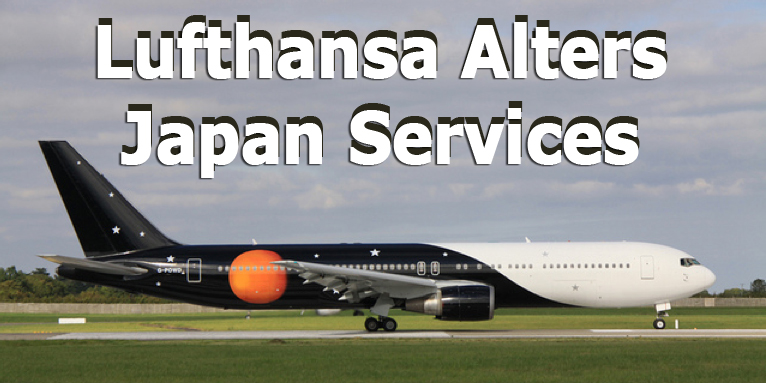Lufthansa
Alters Japan Services
2011 is slowly becoming
the year of the global community, with constant reminders that we are
all downwind from each other and there are no safe corners from crises.
Right now Japan is dealing with horrible aftershocks, tsunami, and fragile
nuclear reactors; in the Middle East the advancing crisis is now centered
at Bahrain where oil costs are rising. Amidst all this upheaval, air
cargo is realizing the impact.
In Europe, Lufthansa Cargo has cancelled
all flights to and from Narita due to three reasons:
•
The ground handling capacities are totally depleted at Tokyo's major
gateway.
•
Huge loads of relief goods are arriving there that have to be prioritized
for humanitarian reasons in order to get them northbound as quickly
as possible to the inhabitants at the quake and tsunami-hit regions.
•
To preserve the well being of LH Cargo's own Tokyo-based staff.
Instead of serving Narita, the carrier
has diverted all flights to Osaka (Kansai airport), upping the movements
from five weekly to twelve.
“Every shipment to be loaded on
board of Lufthansa Cargo's MD-11Fs from Japan is being thoroughly checked
with a geiger counter to monitor any radioactive contamination of people,
goods and equipment,” assured Head of Corporate Communication,
Nils Haupt.
Herr Haupt added that, “Lufthansa
pilots are laying over in Seoul, South Korea instead of resting overnight
in Japan,” as is the case during normal times.
"We land, unload and load our aircraft
and get out right after, thus minimizing the threats caused by the nuclear
disaster," Nils stated.
Lufthansa's passenger flights circumvent
Tokyo as well, landing in Nagoya (Munich flights) and Kansai (Frankfurt
flights) for the time being.
Like their cargo colleagues, the passenger
flight crews are laying over in Seoul as well.
Frankfurt-Hahn airport said that it moved
a Boeing 767 flight chartered by the federal agency THW (Technisches
Hilfswerk) on behalf of the German government.
Last weekend the organization deployed
a Special Forces team from the Rapid Deployment Unit Search and Rescue
Abroad (SEEBA) to Japan.
The 38 SEEBA members are experts in search
and rescue operations in disaster areas. Loaded on board the aircraft
were twelve tons of equipment and accessories as well as a number of
search dogs to locate missing people.
The B767 was chartered from British capacity
provider, Titan Airways.
German airports Frankfurt and Munich have
begun checking all aircraft for radioactive contamination arriving from
Japanese airports. Munich reports finding some minor contamination on
the hull of an All Nippon Airways jetliner that came from Tokyo.
Authorities say, dosimetric measurings
within the cabin and lower deck cargo compartments have not indicated
any abnormalities. Meanwhile the ANA aircraft was officially given a
green light for its return to Japan.
Heiner Siegmund/Flossie
Air
Cargo Report From On The Ground In Japan
Last
Friday afternoon March 11, a gigantic earthquake measuring 9.0
on the Richter scale hit eastern Japan. It was the largest earthquake
ever on record for Japan. The initial quake was then followed
by a gigantic tsunami, which swept deep inland, rapidly engulfing
homes, buildings and vehicles.
FlyngTypers has heard from the people
at APEX in Tokyo & Osaka; they report that they and their
families are all safe, but that they are all “stunned and
in disbelief.”
With public transportation no longer
operating at normal levels and many trains suspended, APEX reports
that while some have gone back to office, many are forced to report
in from home to avoid the commute problem.
A representative from APEX reports,
“In Osaka/Kobe & Nagoya, normal operations resumed in
both airport/seaport and warehouse. In Tokyo & Yokohama, the
airport, seaport & warehouse are in operation, but there are
long lines and delays everywhere.”
All APEX offices are running understaffed,
as many are still unable to commute to work.
“The main problem we are facing
right now is the local delivery and pick-up. At gas stations there
are mile-long lines and many stations are closed as well. The
government has imposed electric suspension for 2-3 hours a day,
with some areas facing this suspension twice a day.”
A suspension of electric power has
lead to the closure of gas stations, train stations and toll-ways
as well. Public transportation is completely paralyzed across
wide areas. As times passes, Japan continues to feel aftershocks.
“As you all have seen, the
news footage of the disaster is beyond all description. Towns
were swept away and roads are filled with driftwood. As more and
more bodies are being recovered, it has become more and more difficult
to deal with. It is a hellish sight. Now, besides the fear of
aftershock, we have to fear the reactor meltdown. We will remain
united and we will stay strong to overcome this. We will also
continue to serve all of our clients as well, and continue to
update you here.”
If you would like to help with the
relief efforts in Japan, an American donation of $10 can be made
to the Red Cross by texting RED CROSS to 9099 from your mobile
phone. Our readers who are frequent flyers (… all of you?)
can also donate miles to the Red Cross via Continental, Delta
or United to fly out relief workers. Donations can also be made
to Doctors
Without Borders.
Flossie |
|




